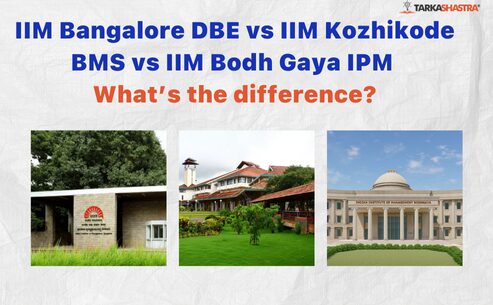The Integrated Program in Management Aptitude Test (IPMAT) conducted by IIM Rohtak has emerged as one of the most competitive entrance exams for Class 12 students aspiring to pursue management education early in their careers. With thousands of aspirants applying each year and limited seats available, the cutoff scores become a critical benchmark in the selection process.
Understanding the IPMAT Rohtak cutoff is not just about knowing the qualifying score—it’s about setting clear targets for preparation, identifying your competition, and gauging your chances of selection based on category-wise performance.
In this blog, we’ll give you a comprehensive breakdown of:
- Expected cutoffs for IPMAT Rohtak 2026
- Previous year (2025, 2024, 2023) category-wise cutoffs
- Factors that influence cutoff trends
- Tips to use the cutoff data smartly in your preparation
Whether you belong to the General, OBC, SC, ST, EWS, or PwD category, this guide will help you estimate the minimum score you need to aim for.
Let’s dive in and decode the cutoff puzzle for IIM Rohtak IPM 2026.
What is IPMAT Rohtak?
The IPMAT Rohtak (Integrated Programme in Management Aptitude Test) is the entrance exam conducted by IIM Rohtak for admission into its prestigious 5-Year Integrated Programme in Management (IPM). This program offers students a unique opportunity to secure a direct pathway to an IIM right after Class 12—without needing to take the CAT exam later.
Why is IPMAT Rohtak Important?
- It provides early entry into IIM Rohtak, bypassing the traditional post-graduation route.
- The IPM course blends management studies with foundational skills, helping build leadership early on.
- Candidates are selected based on aptitude test scores and a personal interview, making the cut-off scores extremely significant.
IPMAT Rohtak 2026 Exam Pattern Overview
Before diving into cut-offs, it’s essential to understand the structure of the IPMAT Rohtak exam.
| Section | No. of Questions | Time Limit | Type of Questions | Marking Scheme |
| Quantitative Ability (QA) | 40 | 40 minutes | Multiple Choice (MCQ) | +4 for correct, -1 for incorrect |
| Logical Reasoning (LR) | 40 | 40 minutes | Multiple Choice (MCQ) | +4 for correct, -1 for incorrect |
| Verbal Ability (VA) | 40 | 40 minutes | Multiple Choice (MCQ) | +4 for correct, -1 for incorrect |
| Total | 120 | 120 minutes | — | — |
Key Highlights
- Unlike IPMAT Indore, which includes Short Answer questions, the test is completely MCQ-based.
- No section switching is allowed. Each section is time-bound for 40 minutes.
- The exam is conducted online at designated centers and includes negative marking for incorrect responses.
Why Does This Matter for Cut-Offs?
Since each section is equally weighted, and the total score is based solely on this aptitude test (followed by an interview), the overall and category-wise cut-offs depend heavily on:
- Difficulty level of the paper
- Distribution of scores across candidates
- Section-wise performance, particularly in QA (which is often the most challenging)
So, understanding this structure helps you estimate how many marks you must aim for to cross the cut-off threshold for your category.
Summary
IPMAT Rohtak tests three core areas—quantitative Ability, Logical Reasoning, and Verbal Ability—with equal weightage regarding the number of questions and time.
Understanding the syllabus, structure, and difficulty level is the first step toward effectively estimating cut-offs and planning your preparation strategy.
Number of Seats and Role of Cut-Offs in Shortlisting
IIM Rohtak offers approximately 180-200 seats for its IPM program (based on recent admission trends). These are distributed across various reservation categories—general, EWS, OBC-NCL, SC, ST, and PwD—as per government norms.
Given the massive number of applicants (over 14,000+) and the limited seats available, the institute uses cut-offs as the first shortlisting tool. Only candidates who score above the category-specific cut-off in the IPMAT are invited for the next round—typically a Personal Interview (PI).
Knowing the expected and previous year cut-offs is essential for every serious aspirant. It helps in:
- Setting a clear target score
- Managing time and section-wise efforts
- Evaluating one’s performance in mocks and actual exam attempts
Factors Determining IPMAT Rohtak Cut Off 2026
IPMAT Rohtak cut-offs don’t appear out of thin air. Each year, they are shaped by a dynamic mix of variables that impact both the overall difficulty of the exam and the competition level among students.
Understanding these factors is crucial to setting realistic score targets and adjusting your preparation strategy accordingly.
1. Total Number of Applicants
The more aspirants that appear for the exam, the higher the competition. IPMAT Rohtak has witnessed over 14,000 registrations in recent years, with increasing participation from students across CBSE, ICSE, and state boards. Naturally, higher participation pushes cut-offs slightly upward.
2. Difficulty Level of the Paper
If the exam is more challenging than usual, the cut-off tends to drop, and vice versa. For example:
- A Quant-heavy paper with tricky DI or algebra might lower overall scores.
- A paper with easier LR or VA sections can cause score inflation, raising cut-offs.
So, students must factor in sectional difficulty while analyzing mocks and setting goals.
3. Number of Seats and Reservation Policies
With only around 180-200 total seats, cut-offs vary significantly across categories. Here’s a rough seat allocation (as per government norms):
| Category | Approx. % Reservation |
| General | ~40–45% |
| OBC-NCL | 27% |
| SC | 15% |
| ST | 7.5% |
| EWS | 10% |
| PwD | 5% horizontal |
Fewer seats in a category can result in higher cut-offs, mainly if many top performers belong to that category.
4. Performance Trends in Specific Sections
Even though IPMAT Rohtak doesn’t enforce sectional cut-offs, poor performance in one section can still impact the total score and your chances of shortlisting. For instance:
- QA is generally considered the toughest and has historically been the score differentiator.
- LR and VA often score more; hence, strong performance here can compensate somewhat.
5. Exam-Day Pressure and Time Management
Since each section is time-bound and there’s no switching allowed, a candidate’s ability to manage time plays a crucial role in their final score. Many aspirants report losing marks due to:
- Spending too much time on QA
- Rushing through VA without accuracy
Hence, a well-balanced approach is key to crossing the cut-off threshold.
In summary, cut-offs reflect how many questions you answer and how well you compete under pressure, within time, and across sections. Now that we’ve decoded the influencing factors, let’s move to the expected cut-off for IPMAT Rohtak 2026 based on trends and expert predictions.
IPMAT Rohtak 2026 Expected Cut Off (Category-Wise)
While the official cut-off for IPMAT Rohtak 2026 will only be declared after the exam and result announcement, aspirants can gain a decisive advantage by estimating a target score range based on previous years’ trends, difficulty levels, and rising competition.
At Tarkashastra, we’ve analyzed 2023, 2024, and 2025 data to project realistic and category-specific expected cut-offs for 2026.
Expected Overall Cut Off – IPMAT Rohtak 2026
| Category | Expected Cut Off Score (Out of 480) |
| General | 315 – 330 |
| EWS | 280 – 295 |
| OBC-NCL | 265 – 280 |
| SC | 210 – 225 |
| ST | 160 – 180 |
| PwD | 130 – 150 |
Note: These estimates assume a moderate difficulty level similar to 2025. A tougher or easier paper may slightly alter the range.
How to Use This Information Effectively
- Set your mock test target 10–15 marks above the expected cut-off for your category.
- Focus more on QA and LR, which determine the top scorer band.
- Ensure consistent performance across all sections. Even if sectional cut-offs aren’t enforced, balanced scoring improves chances during shortlisting.
Why Cut-Offs Can Fluctuate:
- Sudden surge in high-performing candidates
- Change in exam difficulty (especially the QA section)
- Variation in seat intake or reservation policy
So, if you’re aiming for IIM Rohtak in 2026, use this table not as a guess—but as a goalpost. In the next section, we’ll show you actual cut-off scores from previous years to help you further fine-tune your preparation.
Applicants who were called for IPM Aptitude Test on May 5, 2025
| Category | Female | Male | Total |
| General | 4,808 | 5,412 | 10,220 |
| EWS | 263 | 450 | 713 |
| NC-OBC | 827 | 1,169 | 1,996 |
| SC | 270 | 337 | 607 |
| ST | 57 | 102 | 159 |
| DAP | 34 | 75 | 109 |
| Total | 6,259 | 7,545 | 13,804 |
Applicants who attended the IPM Aptitude Test on May 5, 2025
| Category | Female | Male | Total |
| General | 4,607 | 5,192 | 9,799 |
| EWS | 234 | 402 | 636 |
| NC-OBC | 730 | 1,051 | 1,781 |
| SC | 221 | 276 | 497 |
| ST | 37 | 70 | 107 |
| DAP | 19 | 44 | 63 |
| Total | 5,848 | 7,035 | 12,883 |
Applicants who attended IPM Aptitude Test on May 5, 2025 (DAP Category)
| Category | Female | Male | Total |
| DAP-General | 15 | 30 | 45 |
| DAP-EWS | 1 | 2 | 3 |
| DAP-NC-OBC | 2 | 3 | 5 |
| DAP-SC | 1 | 4 | 5 |
| DAP-ST | 0 | 5 | 5 |
| Total | 19 | 44 | 63 |
IPMAT Rohtak Cut-Off 2025
Minimum Cut-off Marks and No. of Applicants meeting cut-off marks
| Category | Min. Cut-off Marks | Female | Male | Total |
| General | 381 | 144 | 310 | 454 |
| EWS | 331 | 17 | 71 | 88 |
| NC-OBC | 297 | 80 | 164 | 244 |
| SC | 230 | 61 | 75 | 136 |
| ST | 138 | 26 | 43 | 69 |
| DAP-General | 274 | 5 | 10 | 15 |
| DAP-EWS | 236 | 1 | 1 | 2 |
| DAP-NC-OBC | 196 | 1 | 2 | 3 |
| DAP-SC | 202 | 1 | 1 | 2 |
| DAP-ST | 171 | 0 | 1 | 1 |
| Total | – | 336 | 677 | 1013 |
No. of Applicants Shortlisted for Personal Interview
| Category | Total |
| General | 454 |
| EWS | 88 |
| NC-OBC | 244 |
| SC | 136 |
| ST | 69 |
| DAP | 22 |
| Total | 1013 |
IPMAT Rohtak Previous Year Cut-Off
The following tables present the cut-off trends for IPMAT Rohtak over the past few years:
IPMAT Rohtak 2024 Official Cut-Off Marks
The cut-off for IPMAT Rohtak varies each year depending on factors such as the difficulty level of the exam, the total number of applicants, and their overall performance.
The table below displays the official IPMAT Rohtak cut-off for 2024:
| Category | Official Cut-off Marks for IPMAT Rohtak 2024 |
| GEN | 301 |
| EWS | 264 |
| NCOBC | 225 |
| SC | 167 |
| ST | 118 |
| DAP-GEN | 260 |
| DAP-EWS | 212 |
| DAP-NCOBC | 189 |
| DAP-SC | 142 |
Minimum Cut-Off Marks and Number of Applicants Clearing IPMAT Rohtak Cut Off
According to the authorities, although the number of candidates appearing for the exam has decreased this year, the number of students who met the IIM Rohtak IPM cut-off has risen to 831.
| Category | Minimum Cut-off Marks | Female | Male | Total No. of Applicants Shortlisted for Personal Interview |
| General | 301 | 98 | 289 | 387 |
| EWS | 264 | 16 | 60 | 76 |
| NCOBC | 225 | 62 | 145 | 207 |
| SC | 167 | 53 | 65 | 118 |
| ST | 118 | 17 | 24 | 41 |
| DAP-General | 260 | 0 | 1 | 1 |
| DAP-EWS | 212 | 0 | 0 | 0 |
| DAP-NCOBC | 189 | 1 | 0 | 1 |
| DAP-SC | 142 | 0 | 0 | 0 |
| Total | – | 247 | 584 | 831 |
Statistics Influencing the IPMAT Rohtak Official Cut-Off 2024
Applicants for the IPM Aptitude Test on May 18, 2024
This year, 14,766 candidates were invited to appear for the exam on May 18, 2024, of which 13,414 appeared. Below are the IPMAT Rohtak cut-off details for 2024:
| Category | Female | Male | Total |
| General | 5,293 | 6,136 | 11,429 |
| EWS | 274 | 485 | 759 |
| NCOBC | 768 | 1,115 | 1,883 |
| SC | 206 | 337 | 543 |
| ST | 38 | 60 | 98 |
| DAP | 13 | 41 | 54 |
| Total | 6,592 | 8,174 | 14,766 |
Applicants who attended the IPM Aptitude Test on May 18, 2024
| Category | Female | Male | Total |
| General | 4,802 | 5,513 | 10,315 |
| EWS | 267 | 466 | 733 |
| NCOBC | 711 | 1,025 | 1,736 |
| SC | 186 | 303 | 489 |
| ST | 36 | 56 | 92 |
| DAP | 11 | 38 | 49 |
| Total | 6,013 | 7,401 | 13,414 |
Applicants who attended the IPM Aptitude Test on May 18, 2024 (DAP Category)
| Category | Female | Male | Total |
| General | 7 | 31 | 38 |
| EWS | 0 | 2 | 2 |
| NCOBC | 4 | 4 | 8 |
| SC | 0 | 1 | 1 |
| ST | 0 | 0 | 0 |
| Total | 11 | 38 | 49 |
It acts as a screening process to ensure that only candidates who meet the quality standards of the participating institute are admitted.
IPMAT Rohtak Cut Off 2023 [Official]
| Category | Cut-off Marks |
| GEN | 409 |
| EWS | 376 |
| NCOBC | 349 |
| SC | 274 |
| ST | 201 |
| DAP-GEN | 238 |
| DAP-EWS | 91 |
| DAP-NCOBC | 91 |
| DAP-SC | 91 |
Minimum Cut-off Marks and No. of Applicants meeting cut-off marks
| Category | Minimum Cut-off Marks | Female | Male | Total |
| General | 409 | 119 | 204 | 323 |
| EWS | 376 | 16 | 52 | 68 |
| NCOBC | 349 | 51 | 117 | 168 |
| SC | 274 | 27 | 72 | 99 |
| ST | 201 | 19 | 28 | 47 |
| DAP-General | 238 | 5 | 11 | 16 |
| DAP-NCOBC | 91 | 3 | 5 | 8 |
| DAP-SC | 91 | 0 | 1 | 1 |
| DAP-ST | 91 | 1 | 0 | 1 |
| Total | — | 241 | 490 | 731 |
Statistics Determining the IPMAT Rohtak Cut Off 2023 [Official]
Applicants who were called for the IPM Aptitude Test on May 20, 2023
| Category | Female | Male | Total |
| General | 5201 | 6411 | 11612 |
| EWS | 268 | 531 | 799 |
| NCOBC | 741 | 1238 | 1979 |
| SC | 210 | 342 | 552 |
| ST | 37 | 69 | 106 |
| DAP | 20 | 40 | 60 |
| Total | 6477 | 8631 | 15108 |
Applicants who attended the IPM Aptitude Test on May 20, 2023
| Category | Female | Male | Total |
| General | 4819 | 5872 | 10691 |
| EWS | 258 | 504 | 762 |
| NCOBC | 686 | 1149 | 1835 |
| SC | 197 | 317 | 514 |
| ST | 34 | 61 | 95 |
| DAP | 20 | 37 | 57 |
| Total | 6014 | 7940 | 13954 |
Applicants from the DAP category who appeared for the IPM Aptitude Test on May 20, 2023
Below are the IPMAT Rohtak cut-off marks for candidates in this category.
| Category | Female | Male | Total |
| General | 16 | 31 | 47 |
| EWS | 0 | 0 | 0 |
| NCOBC | 3 | 5 | 8 |
| SC | 0 | 1 | 1 |
| ST | 1 | 0 | 1 |
| Total | 20 | 37 | 57 |
Total Number of Applicants Shortlisted for the Online Personal Interview
Candidates Invited for the IPMAT Rohtak Interview Round:
| Category | Total |
| GEN | 323 |
| EWS | 68 |
| NCOBC | 168 |
| SC | 99 |
| ST | 47 |
| DAP | 26 |
| Total | 731 |
Note: Candidates are encouraged to use topper insights and strategies to enhance their IPMAT performance and boost their cut-off scores.
IPMAT Rohtak 2022 Cut-Off
The following table presents the category-wise cut-off marks for IIM Rohtak in the year 2022.
| Category | Cut-Off Marks |
| General | 306 |
| NC-OBC | 219 |
| SC | 154 |
| ST | 66 |
| EWS | 261 |
| PwD | 185 |
IPMAT Rohtak 2021 Cut-Off
The table below displays the category-wise cut-off marks for the IIM Rohtak IPM admission in 2021.
| Category | Cut-Off Marks |
| General | 265 |
| NC-OBC | 80 |
| SC | 119 |
| ST | 52 |
| EWS | 197 |
| PwD | 40 |
IPMAT Rohtak 2020 Cut-Off
The following table highlights the category-wise cut-off scores for IIM Rohtak admissions 2020.
| Category | MCQs Cut-off Marks | WAT Cut-off Marks |
| General | 144 | 48 |
| NC-OBC | 120 | 40 |
| SC | 96 | 32 |
| ST | 96 | 32 |
| EWS | 120 | 40 |
| PwD | 120 | 40 |
IPMAT Rohtak 2019 Cut-Off
The table below presents the category-wise cut-off scores for IIM Rohtak admissions 2019.
| Category | MCQs Cut-Off Marks |
| General | 256 |
| NC-OBC | 195 |
| SC | 157 |
| ST | 141 |
| EWS | 206 |
| PwD | 186 |
Category-Wise Cut Off Trends: What You Can Learn
Cut-off scores in IPMAT Rohtak are not static—they evolve yearly based on multiple factors like exam difficulty, competition level, and overall candidate performance. However, by analyzing past trends, you can gain powerful insights into how cut-offs behave across categories and what this means for your preparation strategy.
Below is a comparative table showing the official minimum cut-off marks from 2019 to 2025 across categories:
IPMAT Rohtak Cut Off Trends (2019–2025)
| Year | General | EWS | OBC-NCL | SC | ST | PwD |
| 2025 | 381 | 331 | 297 | 230 | 138 | 130–274* |
| 2024 | 301 | 264 | 225 | 167 | 118 | 142–260* |
| 2023 | 409 | 376 | 349 | 274 | 201 | 91–238* |
| 2022 | 306 | 261 | 219 | 154 | 66 | 185 |
| 2021 | 265 | 197 | 80 | 119 | 52 | 40 |
| 2020 | 144† | 120† | 120† | 96† | 96† | 120† |
| 2019 | 256 | 206 | 195 | 157 | 141 | 186 |
- *PwD cut-offs vary by sub-category (General, EWS, OBC, SC, ST)
- †2020 included separate WAT cut-offs, not just MCQ scores.
Insights from the Cut Off Data
1. General Category Cut-Offs Show High Variability
- Peaked in 2023 at 409, dropped sharply to 301 in 2024, and bounced back to 381 in 2025.
- The fluctuation reflects varying difficulty levels and possibly changes in seat allocation or reservation effects.
2. OBC-NCL and EWS Cut-Offs Rising Consistently
- OBC cut-offs rose from 80 (2021) to 297 (2025) — a 3.7x increase in just four years.
- EWS cut-offs have moved from 197 (2021) to 331 (2025), indicating a tight competition within reserved categories.
3. SC/ST Categories Also Seeing Upward Pressure
- SC cut-off has gone from 119 (2021) to 230 (2025).
- ST cut-off rose from 52 (2021) to 138 (2025).
- These trends suggest aspirants from these categories perform better each year, pushing cut-offs higher.
4. DAP Category Cut-Offs Remain Variable
- PwD (DAP) cut-offs range widely depending on the sub-category.
- For example, the DAP-General cut-off in 2025 was 274, while the DAP-SC was 202.
- Indicates fewer candidates and diverse scoring patterns.
What This Means for You
- General & EWS aspirants need to consistently target 320+ in mocks to stay safe.
- OBC candidates should aim for 280+, given the rapid increase in cut-offs.
- SC/ST aspirants must not underestimate the competition—a safe score now lies above 200.
- All candidates should track their mock scores against these trend lines and adjust section-wise focus accordingly.
By understanding how cut-offs have evolved across years and categories, you set better targets and avoid complacency. Remember: cut-offs reflect the minimum performance of selected students. To truly secure your seat, aim well above the minimum.
What is a Good Score in IPMAT Rohtak 2026?
Regarding competitive exams like IPMAT Rohtak, “good” is subjective. But from a strategic preparation perspective, a good score keeps you comfortably above the category-wise cut-off. It increases your chances of getting shortlisted for the personal interview (PI) round.
Let’s break it down further.
How to Define a Good Score in 2026
Based on the trends from 2019 to 2025 and the expected competition level in 2026, here’s a table showing what qualifies as a “good score” for each category:
| Category | Expected Cut Off (2026) | Safe / Good Score to Aim For |
| General | 315–330 | 340–360+ |
| EWS | 280–295 | 310–320+ |
| OBC-NCL | 265–280 | 290–300+ |
| SC | 210–225 | 240–250+ |
| ST | 160–180 | 190–200+ |
| PwD (DAP) | 130–150 | 160–180+ |
A good score gives you a 10–15% buffer over the expected cut-off to absorb surprises like a tougher-than-expected paper or normalization factors.
Section-Wise Targets for a Good Score
Each section contributes 160 marks (40 questions × 4). If you’re targeting a total score of 340+, here’s how your ideal section-wise breakup should look:
| Section | Target Correct Attempts | Target Score |
| Quantitative Ability | 24–26 questions | 96–104 |
| Logical Reasoning | 26–28 questions | 104–112 |
| Verbal Ability | 28–30 questions | 112–120 |
| Total | 78–84 correct | 340–360+ |
These are net scores, assuming minimal negative marking. Accuracy matters more than over-attempting.
What Determines a “Good” Score for You Personally?
- Your category and seat availability
- Your accuracy in mocks
- Your strengths in specific sections
- Your performance under time pressure
You’re on the right track if you’re getting close to the target in mocks. If not, focus on:
- Improving speed in QA
- Mastering puzzles in LR
- Boosting reading accuracy in VA
Bottom Line
A good score is not topping the exam—it’s about comfortably clearing the cut-off and staying in the safe zone for PI shortlisting. Whether you’re targeting 340 or 250, tracking your progress through mock tests and adapting your prep strategy regularly is key.
How to Use Cut-Offs for Strategic Preparation
Knowing the IPMAT Rohtak cut-offs is not just about curiosity—it’s about using that information to craft a focused and efficient preparation strategy. Cut-offs are like milestones on your preparation journey: they help you gauge how far you need to go and what pace you should maintain.
Here’s how you can use cut-off data strategically to maximize your chances of success.
1. Set a Clear Target Score (Not Just a Passing Score)
Instead of “just clear” the cut-off, aim to score 10–15% above your category’s expected cut-off.
For example:
- If the expected cut-off for your category is 280, set a target of 310–320.
- This buffer allows for unexpected challenges like tougher-than-expected questions, nervousness, or time mismanagement.
2. Benchmark Your Mock Test Scores
Once you know the target score:
- Track your section-wise scores in every mock.
- Compare your scores against the good score benchmarks shared in the previous section.
- Identify sections where you’re consistently underperforming and prioritize them.
Create a tracker like this:
| Mock Test No. | QA Score | LR Score | VA Score | Total | Action Plan |
| Mock 1 | 85 | 90 | 100 | 275 | Focus on QA basics |
| Mock 2 | 102 | 105 | 110 | 317 | Improve LR speed |
3. Focus on High-Weightage Topics Within Sections
Cut-offs are based on total scores, so mastering high-frequency topics can give you an edge.
Use past year weightage data to:
- Prioritize Arithmetic, Algebra, and Data Interpretation in QA.
- Focus on Arrangements, Series, and Coding-Decoding in LR.
- Strengthen Reading Comprehension and Grammar in VA.
4. Don’t Ignore Accuracy and Negative Marking
Even if you attempt 100+ questions, one incorrect answer deducts a full mark. It’s better to attempt 85 questions with 90% accuracy than 110 questions with 70% accuracy.
Strategy Tip: Attempt only those questions for which you are at least 70–80% confident of the answer.
5. Time Management Simulations Based on Cut-Off Goals
Since each section is time-locked, simulate real exam conditions during mocks:
- Stick to 40 minutes per section
- Avoid section switching
- Practice your ideal number of attempts per section based on target scores
6. Track Your Progress Against Cut-Off Milestones
Create a weekly or bi-weekly cut-off checkpoint. For example:
| Week | Mock Score | Target Cut-Off | Gap to Cover | Strategy Tweak |
| Week 1 | 250 | 310 | -60 | Focus on DI & RC |
| Week 3 | 290 | 310 | -20 | Improve speed in QA |
| Week 5 | 325 | 310 | +15 | Maintain accuracy |
Final Word: Use Cut-Offs as a Compass, Not a Ceiling
Cut-offs help you navigate the exam preparation terrain but are not your limit. They’re the bare minimum—your real goal should be to outperform them confidently.
Use them:
- To set mock score goals
- To allocate time between sections
- To avoid overconfidence or under-preparation
When you’re armed with cut-off insights and a smart strategy, you’ll not just cross the line—you’ll be ahead of the curve.
Conclusion
Cracking IPMAT Rohtak isn’t just about solving questions—it’s about understanding the game of cut-offs and playing it strategically.
The cut-off is a reliable compass throughout your preparation journey, from analyzing past years’ trends to setting category-wise score targets. Whether you’re from the General category aiming for 350+, or from OBC, SC, ST, or EWS categories with different benchmarks, your score planning must be intentional and data-driven.
Let’s quickly recap what you’ve learned:
- IPMAT Rohtak is a highly competitive exam with nearly 14,000+ serious applicants every year
- The cut-offs vary widely by category and have shown a clear upward trend since 2020
- A “good score” is always 10–15% above the cut-off, offering a safe cushion
- Mock test benchmarking, topic prioritization, and time-bound practice are key to beating the cut-off
- Using cut-off trends allows you to strategize, not just prepare blindly
At Tarkashastra, we believe that exams aren’t just about talent—they’re about preparation with precision. Our mentors, mock tests, and strategy sessions are designed to help you break past the cut-off barrier and shine in the interview round.
Remember: The cut-off is not the destination. It’s the first milestone on your road to IIM Rohtak.
Ready to go beyond the cut-off?
Join Tarkashastra’s IPMAT Rohtak 2026 prep program and take the guesswork out of your preparation. From daily drills to personalized mentorship, we’ve covered everything to help you make it to the final list.
FAQs
1. What is the IPMAT Rohtak exam?
IPMAT Rohtak is the Integrated Program in Management Aptitude Test conducted by IIM Rohtak. It is designed for Class 12 students who wish to pursue the 5-year Integrated Program in Management (IPM). The exam tests aptitude in Quant, Verbal, and Logical Reasoning.
2. How many sections are there in IPMAT Rohtak 2026?
There are three sections: Quantitative Ability (QA), Logical Reasoning (LR), and Verbal Ability (VA). Each section has 40 multiple-choice questions. All sections are time-bound, with 40 minutes allotted individually.
3. What is the total duration of the IPMAT Rohtak exam?
The exam is conducted over 120 minutes, with each of the three sections allotted 40 minutes. Candidates cannot switch sections during the test. Time management within each section is crucial.
4. Is there negative marking in IPMAT Rohtak?
Yes, the marking scheme is +4 for a correct answer and -1 for an incorrect one. Unattempted questions carry no penalty. Maintaining accuracy is essential to avoid unnecessary score deductions.
5. What is the expected cut-off for the General category in 2026?
The expected cut-off is between 315 and 330 marks out of 480. For a safer margin, aspirants are advised to aim for a score of 340–360. This range accounts for normal variation in difficulty.
6. What was the cut-off for the General category in 2025?
In 2025, the General category cut-off was 381 marks. It was one of the highest in recent years, reflecting increased competition. This trend emphasizes the importance of scoring well above the minimum.
7. How many seats are available for the IPM program at IIM Rohtak?
IIM Rohtak offers approximately 180–200 seats for the IPM program. These seats are divided across categories based on government reservation norms. Cut-offs vary depending on competition within each category.
8. What is a good score to aim for in the OBC-NCL category?
A score of 290–300 is considered safe for OBC-NCL candidates. The expected cut-off range is 265–280. Staying 10–15% above the cut-off provides a comfortable shortlisting buffer.
9. Is there a sectional cut-off in IPMAT Rohtak?
No, IIM Rohtak does not officially enforce sectional cut-offs. However, a poor performance in one section can still lower your total score. Balanced preparation across all sections is recommended.
10. Does IPMAT Rohtak have an essay or WAT component?
No, IPMAT Rohtak is an aptitude-based exam with no essay writing or WAT. The next stage after the test is a personal interview (PI), for which candidates are shortlisted based on their total score.
11. What is a good score for the EWS category in 2026?
Candidates from the EWS category should target a score of 310–320. This is higher than the expected cut-off of 280–295. It ensures you’re well within the shortlist range.
12. Why do cut-offs fluctuate every year?
Cut-offs depend on exam difficulty, the number of applicants, and overall candidate performance. A tougher paper may reduce cut-offs, while a higher-performing applicant pool can increase them.
13. What is the exam mode for IPMAT Rohtak?
The exam is conducted online as a computer-based test (CBT). Students appear at designated test centers under strict proctoring and time-bound conditions.
14. What was the cut-off for the SC category in 2025?
The SC category cut-off in 2025 was 230 marks, a significant increase from previous years. Candidates from reserved categories should not underestimate the competition.
15. How does IPMAT Rohtak differ from IPMAT Indore?
IPMAT Rohtak includes Logical Reasoning, while Indore does not. Indore has a Short Answer section, which is absent in Rohtak. The overall structure and weightage also vary between the two.
16. What is the marking scheme of IPMAT Rohtak 2026?
Each correct answer awards 4 marks, and each incorrect one deducts 1 mark. This scoring pattern applies to all three sections. Strategic attempts are crucial for maximizing scores.
17. How can cut-off trends help in preparation?
Cut-off trends help set realistic score targets and track mock performance. They also allow students to plan section-wise preparation and allocate time and effort effectively.
18. What are the most scoring topics in the QA section?
Topics like Arithmetic, Algebra, Percentages, and Data Interpretation often carry the most weight. Mastering these can help boost your score significantly. Practice with timed drills is essential.
19. How should I prepare for the Logical Reasoning section?
Focus on puzzles, seating arrangements, and series-based questions. Practice daily to build speed and accuracy. Visual aids like flowcharts can help solve complex problems faster.
20. What are the key areas to focus on in Verbal Ability?
Reading Comprehension, Grammar (including error spotting), and Vocabulary are crucial. Build a reading habit and revise grammar rules regularly. Practice past RCs to improve understanding and speed.
21. Can I clear the exam if I’m weak in Quant?
Yes, but you’ll need to compensate with strong performance in LR and VA. Focus on mastering basic arithmetic and DI. Avoid skipping Quant entirely as it contributes one-third to the total score.
22. Can I use a calculator during the exam?
Candidates are not allowed to use calculators or electronic aids. They must do all calculations manually. Familiarity with mental math and approximation techniques can be beneficial.
23. How many mocks should I take before the exam?
You should take at least 12–15 full-length mocks and analyze each in depth. Include sectional tests in your routine. Focus on improving speed, accuracy, and time allocation.
24. Is 320 a safe score for the General category?
Based on recent cut-offs, a score of 320 is borderline for the General category. To stay on the safer side, aim for 340–360. This helps absorb fluctuations in difficulty and competition.
25. How does mock test analysis help in clearing cut-offs?
Analyzing mocks helps you identify weak areas, track progress, and adjust strategy. It shows whether you’re consistently meeting or missing your cut-off targets. Regular analysis improves performance over time.







